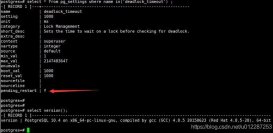1、修改用戶postgres的密碼
|
1
|
#alter user postgres with password ‘xxxx';(其中xxxx是修改的密碼)。 |
2、查看下當(dāng)前schema的所有者:
|
1
2
3
4
5
6
|
SELECT n.nspname AS "Name", pg_catalog.pg_get_userbyid(n.nspowner) AS "Owner"FROM pg_catalog.pg_namespace nWHERE n.nspname !~ '^pg_' AND n.nspname <> 'information_schema'ORDER BY 1; |
3、查詢結(jié)果如圖所示,模式“abc”的所有者為postgresql用戶
針對(duì)模式“abc”, 使用超級(jí)管理員postgresql給普通用戶test授權(quán),命令如下:
|
1
2
3
4
5
6
|
// 最后一條命令就是授予初始權(quán)限grant select on all tables in schema abc to test;grant usage on schema abc to test;alter default privileges in schema abc #將表mytable,授權(quán)給testUser;#GRANT SELECT ON TABLE mytable TO testUser; |
4、查看默認(rèn)權(quán)限
授權(quán)完成,通過pg_default_acl表查看默認(rèn)權(quán)限:
|
1
2
|
// 查看初始權(quán)限select * from pg_catalog.pg_default_acl; |
5、把模式“abc”的擁有者(owner)修改為dbadmin用戶(可以事先創(chuàng)建好),執(zhí)行以下命令:
|
1
2
3
4
5
6
7
8
|
// 修改模式“abc”擁有者為:dbadminALTER SCHEMA abc OWNER TO "dbadmin";// 查看模式的擁有者,相當(dāng)于\du元命令SELECT n.nspname AS "Name", pg_catalog.pg_get_userbyid(n.nspowner) AS "Owner"FROM pg_catalog.pg_namespace nWHERE n.nspname !~ '^pg_' AND n.nspname <> 'information_schema'ORDER BY 1; |
6、postgre查詢所有用戶,postgre中查詢用戶所擁有的權(quán)限
|
1
2
|
select * from pg_roles;select * from pg_user; |
權(quán)限查詢:
|
1
|
select * from information_schema.table_privileges where grantee='cc'; |
查看當(dāng)前用戶的所有權(quán)限
|
1
|
select * from information_schema.table_privileges where grantee='user_name'; |
7、把適用于該對(duì)象的所有權(quán)限都賦予目標(biāo)角色。
用特殊的名字 PUBLIC 把對(duì)象的權(quán)限賦予系統(tǒng)中的所有角色。 在權(quán)限聲明的位置上寫 ALL,表示把適用于該對(duì)象的所有權(quán)限都賦予目標(biāo)角色。
|
1
2
3
4
|
beigang=# grantall on schema csm_ca to public;GRANTbeigang=# revoke all on schema csm_ca frompublic;REVOKE |
8、先創(chuàng)建一個(gè)角色xxx,再創(chuàng)建一個(gè)超級(jí)用戶csm、普通用戶csm_ca,csm用戶創(chuàng)建一個(gè)數(shù)據(jù)庫(kù)testdb,在這個(gè)數(shù)據(jù)庫(kù)里創(chuàng)建一個(gè)schema:csm_ca,然后賦予普通用戶csm_ca操作數(shù)據(jù)庫(kù)testdb里schema:csm_ca里的表的權(quán)限。
|
1
2
3
4
5
|
#create role:#create role xxx with superuser;#Create user:# create user csm with superuserpassword 'csm';# create user csm_ca with password 'csm_ca'; |
9、超級(jí)用戶csm給普通用戶csm_ca授予操作schema csm_ca的權(quán)限
|
1
2
3
4
|
beigang=# grant all on schema csm_ca to csm_ca;GRANTbeigang=# grant all on all tables in schema csm_ca to csm_ca;GRANT |
10、創(chuàng)建用戶
|
1
2
3
4
5
6
7
8
9
10
11
12
13
14
15
16
17
18
19
|
#創(chuàng)建普通用戶postgres=# create user test encrypted password 'test';#創(chuàng)建超級(jí)用戶postgres=# create user test2 superuser;#創(chuàng)建一個(gè)普通用戶,并且賦予相關(guān)權(quán)限# create user test createdb createrole inherit password 'test';#將超級(jí)用戶修改為普通用戶# alter user test nosuperuser;#修改用戶為超級(jí)用戶postgres=# alter user test superuser;#修改用戶密碼postgres=# alter user test2 password 'test';#修改用戶名postgres=# alter user test2 rename to test3;#鎖定/解鎖用戶,不允許/允許其登錄postgres=# alter user test nologin;postgres=# alter user test login;#設(shè)置用戶的連接數(shù),其中0表示不允許登錄,-1表示無限制postgres=# alter user test connection limit 10; |
11、授予用戶數(shù)據(jù)庫(kù)權(quán)限
|
1
|
GRANT ALL PRIVILEGES ON DATABASE 數(shù)據(jù)庫(kù)名 TO 用戶名; |
12、授予用戶查看剛授權(quán)的數(shù)據(jù)庫(kù)的里面的表的權(quán)限
|
1
|
GRANT ALL PRIVILEGES ON TABLE 表名 TO 用戶名; |
13、附帶一條:修改的表的類型
|
1
|
alter table 表名 alter 字段名 type 類型; |
14、附帶一條:增加表新的字段
|
1
|
alter table 表名 add column 字段名 text(字段類型); |
15、新增:設(shè)置主鍵自增
|
1
2
3
4
5
6
7
8
|
CREATE SEQUENCE user_id_seqSTART WITH 1INCREMENT BY 1NO MINVALUE NO MAXVALUECACHE 1; alter table sys_user alter COLUMN id set DEFAULT nextval('user_id_seq'); |
16、新增:postgres創(chuàng)建B-Tree索引
|
1
2
|
-- create index '索引名' on '表名' ('需要索引的字段')CREATE INDEX ip_store_inde on ip_store (ip_network); |
添加各種約束
(1)、 添加主鍵
|
1
|
alter table goods add primary key(sid); |
(2)、 添加外鍵
|
1
|
alter table orders add foreign key(goods_id) references goods(sid) on update cascade on delete cascade; |
on update cascade:被引用行更新時(shí),引用行自動(dòng)更新;
on update restrict:被引用的行禁止更新;
on delete cascade:被引用行刪除時(shí),引用行也一起刪除;
on dellete restrict:被引用的行禁止刪除;
(3). 刪除外鍵
|
1
|
alter table orders drop constraint orders_goods_id_fkey; |
(4). 添加唯一約束
|
1
|
alter table goods add constraint unique_goods_sid unique(sid); |
(5). 刪除默認(rèn)值
|
1
|
alter table goods alter column sid drop default; |
(6). 修改字段的數(shù)據(jù)類型
|
1
|
alter table goods alter column sid type character varying; |
(7). 重命名字段
|
1
|
alter table goods rename column sid to ssid; |
17、創(chuàng)建唯一鍵約束
|
1
|
constraint user_info_unique_userid unique(userid) |
擴(kuò)展
編輯配置文件
文件:postgresql.conf
位置:/var/lib/pgsql/data/postgresql.conf
添加/修改:在所有IP地址上監(jiān)聽,從而允許遠(yuǎn)程連接到數(shù)據(jù)庫(kù)服務(wù)器:
|
1
|
listening_address: '*' |
文件:pg_hba.conf
位置:/var/lib/pgsql/data/pg_hba.conf
添加/修改:允許任意用戶從任意機(jī)器上以密碼方式訪問數(shù)據(jù)庫(kù),把下行添加為第一條規(guī)則:
|
1
|
host all all 0.0.0.0/0 md5 |
以上為個(gè)人經(jīng)驗(yàn),希望能給大家一個(gè)參考,也希望大家多多支持服務(wù)器之家。如有錯(cuò)誤或未考慮完全的地方,望不吝賜教。
原文鏈接:https://blog.csdn.net/qq_40907977/article/details/105395845















